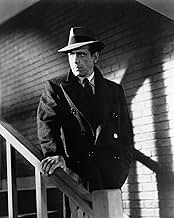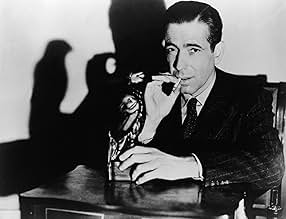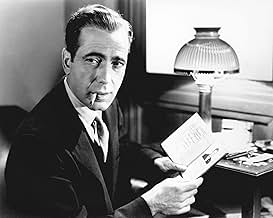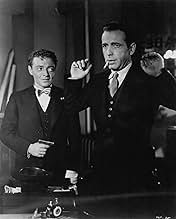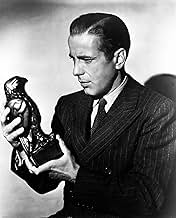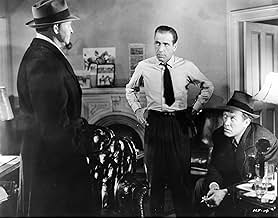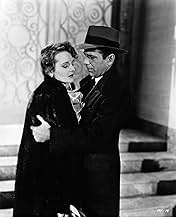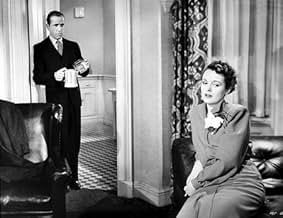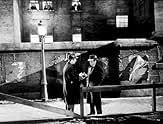Um detetive particular assume um caso que o envolve com três criminosos excêntricos, um magnífico mentiroso e sua busca por uma estatueta incomparável.Um detetive particular assume um caso que o envolve com três criminosos excêntricos, um magnífico mentiroso e sua busca por uma estatueta incomparável.Um detetive particular assume um caso que o envolve com três criminosos excêntricos, um magnífico mentiroso e sua busca por uma estatueta incomparável.
- Direção
- Roteiristas
- Artistas
- Indicado a 3 Oscars
- 8 vitórias e 4 indicações no total
Charles Drake
- Reporter
- (não creditado)
Chester Gan
- Bit Part
- (não creditado)
Creighton Hale
- Stenographer
- (não creditado)
Robert Homans
- Policeman
- (não creditado)
William Hopper
- Reporter
- (não creditado)
- Direção
- Roteiristas
- Elenco e equipe completos
- Produção, bilheteria e muito mais no IMDbPro
Avaliações em destaque
Humphrey Bogart died nearly fifty years ago, but polls still put him at the top of all-time Hollywood stars. What turns a man into a legend? The man himself wasn't much: a slight build, not too tall, no Stallone muscles to swell his suit. What he had in classic films like `The Maltese Falcon' was a voice that cut through a script like a knife. `The Maltese Falcon,' directed by John Huston in 1941, reprised Dashiell Hammett's thriller. (It had been filmed before.) Hammett practically invented the tough guy so deep in cynicism nobody could hope to put anything past him. The novel, thick with plot, wasn't easy for director John Huston to untangle. Few people who cherish this film can summarize its story in a sentence or two. I'll try. San Francisco private eye Sam Spade (Bogart) is pulled into the search for a fabulously valuable statue by a woman who seeks his help. First, his partner is killed, then Spade pushes through her lies to uncover connections to an effete foreigner (Peter Lorre) and a mysterious kingpin (Sydney Greenstreet). The story unfolds like a crumpled paper. But the whodunit becomes less important than how we respond to the strong screen presence of Bogart and his co-stars. That's what makes `The Maltese Falcon' a classic. We see more and appreciate more each time we watch it. The art of Huston and Bogart doesn't come across until a second or third viewing. Huston invented what the French called film noir, in honor of Hollywood films (often `B' movies, cheap to make, second movies in double features) that took no-name stars into city streets to pit tough guys, often with a vulnerable streak, against dangerous dames. Audiences knew that when the tough guy said, `I'm wise to you, babe,' he'd be dead within a reel or two. Bogart was luckier than most noir heroes, but it cost. Struggling to maintain his own independence against the claims of love or his own penchant towards dishonesty the Bogart hero can do little better than surrender, with a rueful shrug, to the irony his survival depends on. The climax of `The Maltese Falcon' ranks with the last scene of `Casablanca,' another Bogart vehicle, in showing how the tough guy has to put himself back together after his emotions almost get the better of him. That assertion of strength, bowed but not broken, defines the enduring quality of Bogart on screen. For Huston, telling this story posed a different problem. Telling it straight wasn't possible too many twists. Huston chose to focus on characters. One way to appreciate Huston's choices is to LISTEN to the movie. Hear the voices. Notice how in long sequences narrating back story, Huston relies on the exotic accents of his characters to keep us interested. Could we endure the scene in which Greenstreet explains the history of the Maltese falcon unless his clipped, somewhat prissy English accent held our attention? Also, we watch Bogart slip into drug-induced sleep while Greenstreet drones on. Has any director thought of a better way to keep us interested during a long narrative interlude? And is there a bit of wit in our watching Bogart nod off during a scene which, if told straight, would make US doze? All of this leads to the ending, minutes of screen time in which more goes on, gesture by gesture, than a million words could summarize. He loves her, maybe, but he won't be a sucker. The cops come in, and the emotional color shifts to gray, the color of film noir heroes like Bogart. Bars on the elevator door as Brigid descends in police custody foreshadow her fate in the last image of Huston's film. But after the film, we're left with Spade, whom we like and loathe, a man whose sense of justice squares, just this once, with our own, maybe. Black and white morality prevails in a black and white movie, but Sam Spade remains gray and so does our response to this film classic.
Considered by many film historians as the very first noir film, "The Maltese Falcon" is cinematically important also for making Humphrey Bogart into a Hollywood star, and for being the debut of John Huston as film Director.
The film's story is complex and convoluted, typical of detective films of that era, and involves a valuable statuette. The plot stalls and meanders throughout most of the film, as we encounter an assortment of strange characters and side issues. But this is not a plot-driven film. It is character-driven.
And the main character, of course, is PI Sam Spade (Bogart). He's not a particularly nice guy. He comes across as overconfident and egotistic. He smirks a lot. But he's tough as nails. And he knows how to nail the bad guys. A big part of the film is Spade's relationship to femme fatale Brigid (Mary Astor). They engage each other in a battle of wits. And there's more than a hint of romantic involvement between the two. But Brigid is the one who propels Spade into the deceiving and double-crossing world of bad guys who yearn with greed for the priceless Maltese Falcon.
Enter Kasper Gutman, that thoroughly rotund and intimidating (in a gentlemanly sort of way) king of greed, portrayed with verve and panache by the inimitable Sydney Greenstreet. Gutman, AKA the "Fat Man", is nothing if not erudite and self-assured. In one scene, Sam Spade makes a bold offer. Gutman responds articulately: "That's an attitude sir that calls for the most delicate judgment on both sides, because as you know sir, in the heat of action, men are likely to forget where their best interests lie ...".
And Peter Lorre is a hoot as Gutman's mischievous elf, Joel Cairo, who tries, without success, to threaten Sam Spade, but only succeeds at getting on Sam's nerves.
The film's high contrast B&W lighting renders an effective noir look and feel, one that would be copied in films for years to come. Acting varies from very good to overly melodramatic. The script is very talky. For the most part, the film is just a series of conversations that take place in interior sets.
Stylistic and cinematically innovative, "The Maltese Falcon" has endured as a film classic. I suspect the main reason for its continued popularity is the continued popularity of Bogart. But I personally prefer the performance of Sydney Greenstreet, the enticing fat man. Yet, together they would reappear in later films, one of which would follow, in 1942, as the classic of all classics.
The film's story is complex and convoluted, typical of detective films of that era, and involves a valuable statuette. The plot stalls and meanders throughout most of the film, as we encounter an assortment of strange characters and side issues. But this is not a plot-driven film. It is character-driven.
And the main character, of course, is PI Sam Spade (Bogart). He's not a particularly nice guy. He comes across as overconfident and egotistic. He smirks a lot. But he's tough as nails. And he knows how to nail the bad guys. A big part of the film is Spade's relationship to femme fatale Brigid (Mary Astor). They engage each other in a battle of wits. And there's more than a hint of romantic involvement between the two. But Brigid is the one who propels Spade into the deceiving and double-crossing world of bad guys who yearn with greed for the priceless Maltese Falcon.
Enter Kasper Gutman, that thoroughly rotund and intimidating (in a gentlemanly sort of way) king of greed, portrayed with verve and panache by the inimitable Sydney Greenstreet. Gutman, AKA the "Fat Man", is nothing if not erudite and self-assured. In one scene, Sam Spade makes a bold offer. Gutman responds articulately: "That's an attitude sir that calls for the most delicate judgment on both sides, because as you know sir, in the heat of action, men are likely to forget where their best interests lie ...".
And Peter Lorre is a hoot as Gutman's mischievous elf, Joel Cairo, who tries, without success, to threaten Sam Spade, but only succeeds at getting on Sam's nerves.
The film's high contrast B&W lighting renders an effective noir look and feel, one that would be copied in films for years to come. Acting varies from very good to overly melodramatic. The script is very talky. For the most part, the film is just a series of conversations that take place in interior sets.
Stylistic and cinematically innovative, "The Maltese Falcon" has endured as a film classic. I suspect the main reason for its continued popularity is the continued popularity of Bogart. But I personally prefer the performance of Sydney Greenstreet, the enticing fat man. Yet, together they would reappear in later films, one of which would follow, in 1942, as the classic of all classics.
I love this movie. I didn't love it until I'd watched it a couple of times.
And I didn't love it quite so much until I'd read Harvey Greenberg's "Movies on Your Mind."
But I now think that, within the strictures of its budget, it's about as good as it can get. Sam Spade is a marvelous character in this film. He gives practically nothing away, while gathering information from others simply by letting them talk, kind of like a shrink.
And it's hard to believe that they could have found a cast that fit the templates of the novel so perfectly. Sidney Greenstreet IS the "fat man." Peter Lorre IS the queer. My nomination for best scene: When Greenstreet attempts to peel off the black enamel from the captured bird and finds that it's nothing but lead and begins to hack away at it, as if it were alive and he were trying to kill it. Nothing is more amusing than a fat man lipid with rage.
If you see this one, and I hope you do, make note of the phenomenal black and white photography. (I hope you have a good connection.) Watch, for instance, the glissade of the camera when Bogart says, "You have brains. Yes, you do."
In case you're worried about this being too sophisticated for enjoyment by an ordinary audience, I should mention that I showed this (in one connection or another, I forget) to a class of Marines at Camp Lejeune. They enjoyed the hell out of it, especially the scene in which Mary Astor kicks Peter Lorre in the shins.
Don't miss it.
And I didn't love it quite so much until I'd read Harvey Greenberg's "Movies on Your Mind."
But I now think that, within the strictures of its budget, it's about as good as it can get. Sam Spade is a marvelous character in this film. He gives practically nothing away, while gathering information from others simply by letting them talk, kind of like a shrink.
And it's hard to believe that they could have found a cast that fit the templates of the novel so perfectly. Sidney Greenstreet IS the "fat man." Peter Lorre IS the queer. My nomination for best scene: When Greenstreet attempts to peel off the black enamel from the captured bird and finds that it's nothing but lead and begins to hack away at it, as if it were alive and he were trying to kill it. Nothing is more amusing than a fat man lipid with rage.
If you see this one, and I hope you do, make note of the phenomenal black and white photography. (I hope you have a good connection.) Watch, for instance, the glissade of the camera when Bogart says, "You have brains. Yes, you do."
In case you're worried about this being too sophisticated for enjoyment by an ordinary audience, I should mention that I showed this (in one connection or another, I forget) to a class of Marines at Camp Lejeune. They enjoyed the hell out of it, especially the scene in which Mary Astor kicks Peter Lorre in the shins.
Don't miss it.
With a fine combination of cast, characters, story, and atmosphere, this classic is one of the most entertaining films of its kind, enjoyable even after several viewings. It gets you right into the action and introduces you to a list of interesting personalities, who mesh together nicely and who are also matched well with the cast members. Beyond that, it's also effective as a character study involving greed, trust and distrust, and conflicting ethics.
Sam Spade is an ideal role for Bogart, giving him plenty to work with and some very good dialogue as well. Peter Lorre and Sydney Greenstreet are very entertaining, providing suitable foils for Bogart, and they really take the film up a notch. The rest of the cast also works well (worth mentioning is Elisha Cook, Jr., whose character doesn't do a lot, but who provides Bogart with some very amusing moments at his expense). The story is nicely adapted from the novel, and each scene is constructed well, with everything moving along nicely from start to finish.
If you are a fan of either film noir or mysteries, make this a must-see. There are very few films that work as well as "The Maltese Falcon".
Sam Spade is an ideal role for Bogart, giving him plenty to work with and some very good dialogue as well. Peter Lorre and Sydney Greenstreet are very entertaining, providing suitable foils for Bogart, and they really take the film up a notch. The rest of the cast also works well (worth mentioning is Elisha Cook, Jr., whose character doesn't do a lot, but who provides Bogart with some very amusing moments at his expense). The story is nicely adapted from the novel, and each scene is constructed well, with everything moving along nicely from start to finish.
If you are a fan of either film noir or mysteries, make this a must-see. There are very few films that work as well as "The Maltese Falcon".
"The Maltese Falcon", scripted and directed by Hollywood first-timer John Huston (from Dashiell Hammett's novel), would go on to become an American film classic. Humphrey Bogart chews the scenery in his star-making turn as acid-tongued private eye Sam Spade, whose association with the beautiful and aloof Brigid O'Shaughnessy (Mary Astor), neurotic Joel Cairo (Peter Lorre), and morbidly obese Kasper Gutman (Sydney Greenstreet, in his Oscar-nominated screen debut) over the recovery of the title object, sets in motion a movie experience that is as much crackling as it is dazzling. While much of the action and dialogue is considerably dated by modern standards, the film's essential power to mystify and entrance remains undiminished despite its age. While this was the third adaptation of Hammett's story (the first was made in 1931 and the second was "Satan Met a Lady" (1936)), this is also the best remembered and most praised, due largely in part to Bogart's seemingly effortless portrayal of the tough but softhearted, world-weary hero. Mary Astor and Lee Patrick were, respectively, the definitive femme fatale and girl Friday, and the villianous roles of Cairo, Gutman and Wilmer (Elisha Cook Jr.) were equally remarkable. What may not be wholly obvious is the fact that these three men have homosexual tendencies (as given in the novel), but just look at what's given: Cairo's delicate speech and manner, Wilmer's questionable quick tempered attitude towards Spade (could this be covering up the fact that he finds Spade attractive?) and Gutman's clutching of Spade's arm when Sam arrives at his hotel room. A polished film noir that gave rise to Bogart's mounting popularity. (Sidenote: The character of Sam Spade was originally offered to George Raft, who turned it down. Raft also turned down "Casablanca" (1942), "High Sierra" (1941) and William Wyler's "Dead End" (1937), all of which went to Bogart and helped to boost his star status. Bogart had Raft to thank for his enduring popularity.) A must-see masterpiece. ****
Você sabia?
- CuriosidadesThree of the falcon statuettes made for the production still exist and are conservatively valued at over $1 million each. This makes them some of the most valuable film props ever made; indeed, each is now worth more than three times what the film cost to make.
- Erros de gravaçãoWhen Spade backslaps Cairo, and Peter Lorre's head snaps to the left, he's wearing a polka dot bow tie, but when his head snaps back to the right, his cravat has become striped.
- Citações
Joel Cairo: You always have a very smooth explanation ready.
Sam Spade: What do you want me to do, learn to stutter?
- Versões alternativasAlso available in a computer colorized version.
- ConexõesEdited into Contos da Cripta: You, Murderer (1995)
Principais escolhas
Faça login para avaliar e ver a lista de recomendações personalizadas
Detalhes
- Data de lançamento
- País de origem
- Idioma
- Também conhecido como
- Relíquia Macabra
- Locações de filme
- Bush Street, San Francisco, Califórnia, EUA(death of Miles Archer)
- Empresa de produção
- Consulte mais créditos da empresa na IMDbPro
Bilheteria
- Orçamento
- US$ 375.000 (estimativa)
- Faturamento bruto nos EUA e Canadá
- US$ 18.180
- Faturamento bruto mundial
- US$ 41.740
- Tempo de duração
- 1 h 40 min(100 min)
- Cor
- Proporção
- 1.37 : 1
Contribua para esta página
Sugerir uma alteração ou adicionar conteúdo ausente



